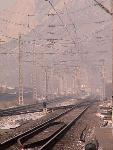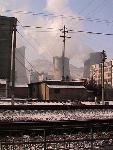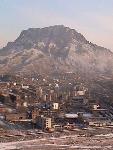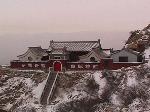- Getting around Lijiang. Dont stay in the Old Towns more than 2 days, there is nothing to do. KRISS Oct 9, 2013 05:46
- 2013 Beijing Temple Fair BENNYLAU Feb 26, 2013 03:29
- Malaysian traveling from KUL - LAX vis Shanghai PVG ZATI_DY Jan 3, 2013 20:15
Spring Festival in Zhangjiakou
- Views: 3921
- |Vote: 0 0
- |Add to Favorites
- |Recommend to Friends
Journey to Zhangjiakou
The nature of travel in China has changed much in recent years for several reasons. Firstly, big business has awoken to the tourism industry and has begun to play the game of working out where people are interested in going and then transforming those places so that travellers are obliged to make use of the expensive creature comforts prepared for them. Many tourists make no bones about this - if a travelator was fixed on to the Great Wall to eliminate the effort of walking along the more scenic areas of its length, I'm sure it would receive many millions more visitors than it does already. Beijing is a prime example of a city that has had its international face refigured within the past ten years; once a thick maze of raw culture, now it is host to grand shopping malls and cafés, fashion stores, the KFC in the historic park. Foreign faces are everywhere, self-important businessmen and loaded holidaymakers in the main, their hotels and restaurants of choice staffed by underpaid English-speaking attendants.
Secondly, the Information Revolution has meant that nowhere is far away anymore as long as it's online in some respect. As a consequence of searching the web, I had arranged an excursion to a small town with one friend who was studying in Beijing; she had invited me to spend the Spring Festival with her family in a remote and undeveloped town called Zhangjiakou.
We were short of time, an expensive taxi ride across town to the Beijing’s South Station saw us arrive with seconds to spare, forcing ourselves into little seats for the three hour's journey deep into northern Hebei province. I amused myself by speaking with my fellow passengers as my friend slept, one a PLA (People's Liberation Army) officer who was delighted to meet a foreigner who could speak some Chinese, and a chubby bespectacled girl who had studied English and spoke with me about her tastes in music. Outside, we were passing through a mountainous terrain broken with small rocky villages; I spotted caves, still host to some of China's troglodyte population. The soil was poor and sparsely vegetated in winter, a feeble river made several understated appearances on its casually majestic stage.
We finally arrived: it was a cold, filthy afternoon and Zhangjiakou squatted unpromisingly on a rare flatland amidst the mountain ranges. The city is an industrial pit for its hardened population of some 12,000 inhabitants at the centre; the city spans several distinct locations around the plain, however, and the total population of these and their satellites numbers close to a million. Centuries before, the region was an important caravan stop for trade routes headed North into Mongolia and Russia, being very close to the Mongolian Pass in the Great Wall. It has changed hands between the Chinese and Mongols a couple of times owing to its strategic location; the Japanese took it in 1937 and attempted to strengthen their own ties with Mongolia, discouraging Chinese colonisation with a few indiscriminate slaughters. The communists took it back in a friendlier fashion before their victory over the Kuo Ming Tang in Beijing. Known to the outside world as the inglorious city of Kalgan, meaning 'gate' in Mongolian, its Chinese name preserves this meaning in the word 'kou' which also means 'gate' or 'mouth'
Into the New Year
My friend’s family lived in a concrete bunker-like home in Zhangjiakou’s Xiahua district, and the fifteen of us were to share three broad table beds called Kangs, which spanned the length of the room and were heated with pipes leading underneath from the furnace. Parents, sisters, brothers, several uncles, aunts and cousins huddled around a table of party dishes. The tradition is to stay up all night; eat until midnight, celebrate with a further meal of dumplings, one of which contains a lucky coin; play until morning when a warm breakfast gives the family to a late morning sleep. All of this is punctuated by constant fireworks and crackers - we all wandered outside onto the tracks at midnight to see the town count in the Chinese New Year. It was snowing lightly, all around the apartment blocks were afire in a display of coloured lights, bright explosions, glowing red globe lanterns; for miles around, sky lotuses flamed in sporadic intervals. In a remote town, the embrace of a timeless national culture touched on short bare villas of stone, Grandparents huddled around the old furnace, unshowered brothers drinking spirits and their children watching Hongkongese pop stars sing in the new spring on CCTV. Half a century still behind Beijing, it was a warm company of faces not seen by most visitors, it was a privilege to be a foreign witness and to be accepted immediately as something like kin.
The evening had been memorable, I had been involved in the preparation of the dumplings which were scoffed as soon as we had come back in from watching the fireworks, and spent most of the night playing at cards with my friend and playing games with her small cousins whose energy was surprising given the late hour. 'Red Pockets' had been distributed by the adults, annual gifts of money given by the older generation to the younger. I was handed a 10 yuan note by an old auntie, who grinned toothlessly as I shook my hands together in the traditional gesture of thanks.
Around Xiahua District
After some sleep, I was shown around the town in the crisp morning air. Not much was open, given that it was a public holiday, but the centre of town was a humble collection of shops and businesses which made small, defiant temples of modernity within the bare huts surrounding the railway. We visited a small park, Shuiquan Gongyuan, a pretty affair of Qing Dynasty stylised walkways around a lake.
What appealed most as I wandered around the city was the beckoning short mountains surrounding the town - I imagined the view from the crest to be a pretty good reason to attempt one of the more manageable ones. We set out after lunch, on what was a splendidly bright day - the mountain (called 'Chimney Mountain') wasn't too difficult to climb, and after a few minutes it became clear just how rewarding a view it was going to be. The tall grass was yellowy straw, the wind blew the cold off the snow up to the summit where we sat chewing long stems and looking out over the city. There seemed to be several centres over the plain in addition to ours at the railside, long roads around the bases of the mountains connected them a steep taxi fare away. The soil was poor from centuries of mineral extraction and millennia of agriculture, deep pits of eroded soil slid away from distant roadsides.
Dominating the horizon was another mountain around three times the elevation of ours, which was named by the famous Dowager Ci Xi during her flight from the Nationalist takeover of Beijing. Zhangjiakou was the terminating station of the first railway from Beijing, and provided a natural escape route as popular revolution forced closure on the centuries of Manchurian dynastic rule. She was a notorious nasty, having surrendered Chinese lands to foreigners without significant resistance, and diverting money for her own vainglorious projects at a time when the military forces were struggling with foreign onslaught. After staying the night in Zhangjiakou, she apparently walked out to a view of the mountain which seemed to her to resemble a crowing rooster (a connection I failed to make myself) and thus named it Ji Ming Shan which means 'Crowing Mountain'. It was a challenge that seemed difficult to meet, but I resolved to discover more about it once we returned home.
Ji Ming Shan
Fortunately, someone else had had the same idea as I'd had when looking out towards Ji Ming Shan - climbing it - only they'd had the idea a thousand or so years beforehand and had gone to the trouble of making it a little bit easier by carving rough pathways along the side. It was still a terribly dangerous climb for a layman, but soon became an attraction not to be missed once I'd heard that there were various Buddhist structures near and on the summit. Apparently, the mountain had been a favourite holy resort for an earlier Dowager in Chinese history, and the structures built on the side date back to the Ming Dynasty several hundred years ago.
My friend and her uncle joined me on the climb. A lower point of ascent was punctuated by a few smaller halls for prayer and rest; after almost an hour we reached a large temple on a crest halfway to the peak. There were two plain clothed devotees present who showed us around the temple grounds, which presented a cold view of the coal dust blanket cloaking Zhang Jia Kou. Here, above the smoke, the air was relatively pure and cold. Life at the temple is not without some luxuries though - we were invited into the quarters of the resident monks who were absent at that time, shopping in the town at the base. Equipped with prayer gong, thermos, telephone and colour TV, prayers were evidently interspersed with the watching of soap operas and the eating of sunflower seeds.
The ascent to the summit took more than an hour, slippery with untouched snow and sharp drops, breathing was careful and cold, steps were hesitant and slow. One cavern contained red rubble believed to cure any disease.
At the top, a bridge carefully connected two neighbouring peaks, one of which was once a smaller residence for monks. Simple huts, now locked, sided small prayer areas. The complex dates back for centuries, now loudspeakers have been fixed to a post to send out blessings over Zhangjiakou. Tablets bore carved comments from Emperors past, carved by their own hand, many still legible with the thoughts and writings of these earlier rulers of China.
Most of the buildings are recent reconstructions, however; the original bridge and temples were destroyed by, with no surprise, the Red Guard. It was during the Cultural Revolution that it was decided that traditional temples were symbolic enemies of modern Communist China, throughout the country zealous teenagers under official sanction steadily razed China's cultural treasures, making the same difficult climb we'd made to desecrate the extraordinary and the sacred.
We wandered down carefully, the descent being just as difficult as the climb. A welcome rest at the monastery gave us the chance to meet one of the monks who'd returned; he opened the small store to sell us some trinkets before heading off to his warm television.
Back at the base of the mountain, evening blued the rubble and dirt, small shacks smoked out their coal like old men's pipes, and their occupants filled old kettles for weak tea and washing water. It grew dark, and the night passed quietly before my friend and I headed back for Beijing on an early train the next morning, leaving behind us a small city of little note still withheld from the forces which have changed the country's capital. Zhangjiakou is seldom the destination of tourists or even the hardiest travellers, still a world unto itself in which new generations continue to trace over the life lines of the old.







 Copyright © 1998-2025 All rights reserved.
Copyright © 1998-2025 All rights reserved.
1.
Apr 12, 2006 15:25 Reply
HELENDANGER said:
Thanks for writing on Zhangjiakou. I visited there twice in the year I lived in China, and both times proved memorable and fun. It's nice to see that someone else has been there and loved it as much as I did.